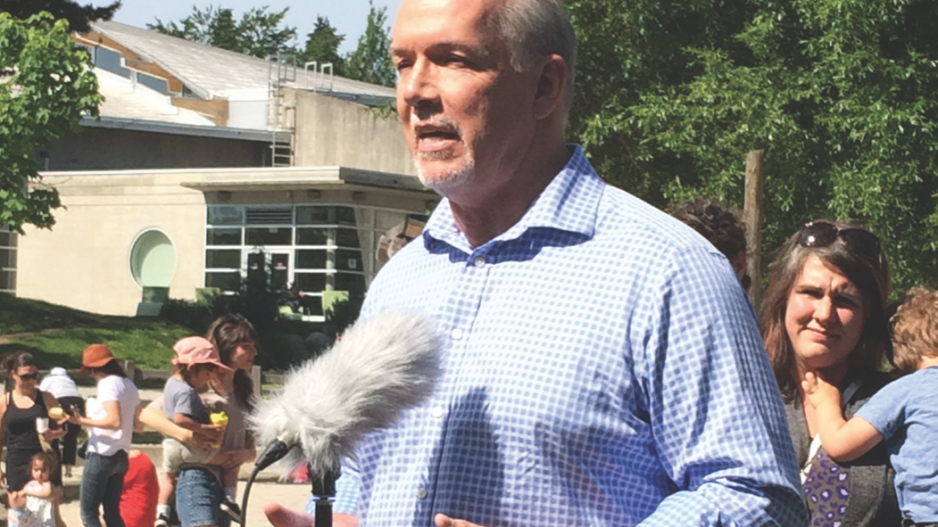Former U.S. defence secretary Donald Rumsfeld once said that there are known knowns, known unknowns and unknown unknowns.
A BC Green Party-backed BC NDP minority government’s plans for spending, taxes and economic development are filled with unknowns – and few things concern business more than uncertainty.
A four-year governance agreement signed by the NDP and Greens has a few known knowns that B.C. businesses can factor into their plans: higher carbon taxes, a phase-out of Medical Services Plan (MSP) premiums and an eventual move to a $15 minimum wage.
It also provides for increased spending on co-op, apprenticeship and work experience programs – measures that some sectors will welcome as a way to address skilled labour shortages.
Everything else is a bit fuzzy – in a potentially expensive way.
There is a pledge, for example, to implement the Green party’s essential-drugs program that would lower the cost of prescription drugs.
That program is not costed, except as part of the Greens’ overall $128 million annual “healthy lives” spending, so how much it will cost is anyone’s guess.
“There’s a lot of expensive items, and not just expensive initially, but expensive over the long term,” said Scott Hennig, interim B.C. director for the Canadian Taxpayers Federation. “And there’s a lot of question marks that have very expensive possibilities.
“If they want to shut down Site C, they’ve already spent $4 billion on that. There’s going to be another $1.5 billion to shut it down. It’s going to be expensive to finish it, it’s going to be expensive to shut it down, but at least if you finish it, you have something – you have an asset. If you don’t finish it, you’ve blown $5.5 billion on nothing.”
BC Hydro confirmed last week that $4 billion had been spent or committed on Site C.
How Hydro would absorb the sunk costs of an unfinished project and then pass them on to ratepayers is one of the many unknowns.
Businesses can expect to pay higher carbon taxes but should not expect corresponding reductions in taxes elsewhere, because the “GreeNDP” plan would not maintain the revenue neutrality of B.C.’s current carbon tax.
Under the BC Liberal model, for every dollar raised in carbon taxes, a dollar is taken off taxes elsewhere. The NDP plan would cut rebate cheques to “the majority” of British Columbians.
Businesses can also start planning for the elimination of MSP premiums. It’s just not clear yet whether they will be replaced with payroll taxes, as per the Green party platform, or something else.
It’s clear, however, that the new government will have to find a new revenue source because eliminating the MSP premiums will blow a $2.5 billion annual hole in the provincial budget.
That $2.5 billion question mark constituted the single largest item in $6.4 billion operating shortfall that the Liberals said they found in the NDP’s proposed budget plan in the lead-up to the May 9 election.
The NDP insisted their budget was fully costed, and it was pointed out that the Liberals had included costs for things the NDP had not proposed – such as a full freeze on ICBC rates.
Absent from the GreeNDP’s four-year agreement is the NDP’s pledge to eliminate tolls on the Golden Ears and Port Mann bridges. The Greens oppose such a move.
Apart from the carbon tax hike, the GreeNDP agreement is silent on taxes. But it’s pretty much a given that the NDP’s first budget will include a 1% corporate income tax hike and an upper tax bracket increase to 16% from 14% for people with annual salaries of $150,000 and higher. The Greens have agreed to support the NDP on budgets.
It’s unclear what the NDP will do with respect to new taxes to curb housing market speculation; the NDP and Greens had widely divergent plans on that score.
As for child care, Horgan put a bit of flesh on the GreeNDP’s skeletal pledge to increase spending in that area.
Horgan confirmed last week that the NDP’s $10-per-day child-care program will be implemented, not the Greens’ more costly free daycare plan. At a press conference, Horgan said the NDP government will build 22,000 new daycare spaces over the first three years and 66,000 over five years as part of a 10-year plan.
He did not put a price tag on the plan, although the NDP platform costs it out at $175 million, $280 million and $400 million, respectively, in the first three years – $855 million in total.
Another known unknown in the GreeNDP plan: what will the road pricing in Metro Vancouver cost?
Last week, the Mayors’ Council on Regional Transportation announced a new commission to implement some form of mobility pricing, which could include tolls and/or per-kilometre pricing that will charge drivers a fee for using the region’s roads based on how far they drive.
The Greens and NDP pledged to match the $2.2 billion in federal funding for transit, so all that is missing is a regional funding source to cover TransLink’s share.
The Liberals vowed that any new levies, like mobility pricing, would have to be approved by Lower Mainlanders in a referendum.
The NDP said no referendum would be required.




